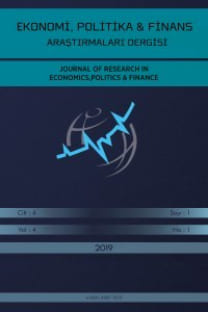Türkiye’de Enerji Arz Güvenliği Riskinin Makroekonomik Etkileri: Vektör Hata Düzeltme Modeli
Enerji Arz Güvenliği, Vektör Hata Düzeltme Modeli, Ekonomik Büyüme
Macroeconomic Effects of Energy Supply Security Risk in Turkey: Vector Error Correction Model
___
- Aghion, P. and Howitt, P. (1998). Endogenous growth theory. Cambridge: The MIT Press.
- Akdiş, M. (2011). Para teorisi ve politikası (2. bs.). Ankara: Gazi Kitapevi.
- Akgül, D. (2015). Gelişmekte olan ülkelerde petrol fiyatlarının enflasyon üzerindeki etkisi (Yayımlanmamış doktora tezi). Gebze Teknik Üniversitesi Sosyal Bilimler Enstitüsü, Gebze.
- André, F. and Smulders, S. (2004, June). Energy use, endogenous technical change and economic growth. Paper presented at the EAERE 13th Annual Conference. Budapest, Hungary. Retrieved from http://www.feem-web.it/ess/ess04/contents/smulders3.pdf
- Aytaç, D. (2010). Enerji ve ekonomik büyüme ilişkisinin çok değişkenli VAR yaklaşımı ile tahmini. Maliye Dergisi, 158, 482-495. Erişim adresi: https://www.hmb.gov.tr/maliye-dergisi/
- Balat, M. (2010). Security of energy supply in Turkey: Challanges and solutions. Energy Conversion and Management, 51(10), 1998-2011. doi:10.1016/j.enconman.2010.02.033
- Balitskiy, S., Bilan, Y. and Strielkowski, W. (2014). Energy security and economic growth in the European Union. Journal of Security & Sustainability Issues, 4(2), 123-130. http://dx.doi.org/10.9770/jssi.2014.4.2(2)
- Cumhurbaşkanlığı Strateji ve Bütçe Başkanlığı. (2019). Ekonomik ve sosyal göstergeler. Erişim adresi: http://www.sbb.gov.tr/ekonomik-ve-sosyal-gostergeler/#1540023014826-f0fb9a57-91ae
- Deese, D. A. (1979). Energy: Economics, politics, and security. International Security. 4(3), 140-153. doi:10.2307/2626698
- Dickey, D. A. and Fuller, W. A. (1981). Likelihood ratio statistics for autoregressive time series with a unit root. Econometrica: Journal of the Econometric Society,49(4), 1057-1072. doi:10.2307/1912517
- Dünya Bankası. (2019). Dünya kalkınma göstergeleri. Retrieved from https://datacatalog.worldbank.org/dataset/world-development-indicators
- Enders, W. (1995). Applied econometric time series. New York: John Wiley & Sons Inc.
- Engle, R. and Granger, C. W. J. (1987). Cointegration and error-correction: Representation, estimation, and testing. Econometrica, 55(2), 251-276. doi:10.2307/1913236
- Erkan, B., Şentürk, M., Akbaş, Y. ve Bayat, T. (2011). Uluslararası ham petrol fiyatlarındaki volatilitenin işsizlik göstergeleri üzerindeki etkisi: Türkiye örneği üzerine ampirik bulgular. Gaziantep Üniversitesi Sosyal Bilimler Dergisi, 10(2), 715-730. Erişim adresi: http://dergipark.org.tr/tr/pub/jss/
- European Commission. (2000). Green paper towards a european strategy for the security of energy supply. Retrieved from https://ec.europa.eu/energy/green-paper-energy-supply
- Gasparatos, A. and Gadda, T. (2009). Environmental support, energy security and economic growth in Japan. Energy Policy, 37(10), 4038-4048. https://doi.org/10.1016/j.enpol.2009.05.011
- Global Energy Institute. (2019). Energy security risk index. Retrieved from https://www.globalenergyinstitute.org/energy-security-risk-index
- Gollop, F. (1969). Structural Inflation 1964-1966. The American Economist, 13(2), 31-39. Retrieved from https://www.jstor.org/
- Gomez-Loscos, A., Gadea, M. D. and Montañés, A. (2012). Economic growth, inflation and oil shocks: Are the 1970s coming back?. Applied Economics, 44(35), 4575-4589. https://doi.org/10.1080/00036846.2011.591741
- Hazine ve Maliye Bakanlığı. (2019). Ekonomi sunumu. Erişim adresi: https://ms.hmb.gov.tr/uploads/2019/05/Ekonomi_Sunumu-2.pdf
- International Energy Agency. (2016). Headline Global Energy Data. Retrieved from https://www.iea.org/media/statistics/IEA_HeadlineEnergyData_2016.xlsx
- International Monetary Found. (2019). World Economic Outlook Database. Retrieved from https://www.imf.org/external/pubs/ft/weo/2019/01/weodata/index.aspx
- Johansen, S. and Juselius, K. (1990). Maximum likelihood estimation and inference on cointegration-with application to the demand for money. Oxford Bulletin of Economics and Statistics, 52(2), 169-210. https://doi.org/10.1111/j.1468-0084.1990.mp52002003.x
- Keane, M. P. and Prasad, E. (1996). The employment and wage effects of oil price changes: A structural analysis. The Review of Economics and Statistic, 78(3), 389-400. doi:10.2307/2109786
- Korkmaz, Ö. ve Develi, A. (2012). Türkiye’de birincil enerji kullanımı, üretimi ve gayri safi yurt içi hasıla (GSYİH) arasındaki ilişki. Dokuz Eylül Üniversitesi İktisadi İdari Bilimler Fakültesi Dergisi, 27(2), 1-25. Erişim adresi: http://dergipark.org.tr/en/pub/deuiibfd/
- Kümmel, R., Henn, J. and Lindenberger, D. (2002). Capital, labor, energy and creativity: Modeling innovation diffusion. Structural Change and Economics Dynamics, 13(4), 415-433. https://doi.org/10.1016/S0954-349X(02)00008-5
- MacKinnon, J. G. (1996). Numerical distribution functions for unit root and cointegration tests. Journal of Applied Econometrics, 11(6), 601-618. https://doi.org/10.1002/(SICI)1099-1255(199611)11:6< 601::AID-JAE417>3.0.CO;2-T
- Özata, E. (2010). Türkiye’de enerji tüketimi ve ekonomik büyüme arasındaki ilişkilerin ekonometrik incelemesi. Dumlupınar Üniversitesi Sosyal Bilimler Dergisi, 26, 101-113. Erişim adresi: http://dergipark.org.tr/en/pub/dpusbe/
- Pesaran, M. H., Shin, Y. and Smith, R. J. (2001). Bounds testing approaches to the analysis of level relationships. Journal of Applied Econometrics, 16(3), 289-326. https://doi.org/10.1002/jae.616
- Phillips, P. C. and Perron, P. (1988). Testing for a unit root in time series regression. Biometrika, 75(2), 335-346. https://doi.org/10.1093/biomet/75.2.335
- Rotemberg, J. J. and Woodford, M. (1996). Imperfect competition and the effects of energy price increases on economic activity (NBER Working Paper No. 5634). Retrieved from https://www.nber.org/papers/w5634.pdf
- Sinan, O. B. (2018). Türkiye’de işsizlik oranları ile uluslararası petrol fiyatları ilişkisi: 1980-2016. Finans Ekonomi ve Sosyal Araştırmalar Dergisi, 3(4), 681-695. doi: 10.29106/fesa.453091
- Smulders, S. and Nooij, M. D. (2003). The impact of energy conservation on technology and economic growth. Resource and Energy Economics, 25(1), 59-79. https://doi.org/10.1016/S0928-7655(02)00017-9
- Tahvonen, O. and Salo, S. (2001). Economic growth and transitions between renewable and nonrenewable energy resources. European Economic Review, 45(8), 1379-1398. https://doi.org/10.1016/S0014-2921(00)00062-3
- Türkiye İstatistik Kurumu. (2019). Ekonomik Göstergeler. Erişim adresi: www.tüik.gov.tr
- Ursavaş, N. ve Yıldırım, E. (2017). Enerji arz güvenliği riskinin Türkiye'nin makroekonomik dengelerine etkisi. AİBÜ Sosyal Bilimler Enstitüsü Dergisi, 17(4), 55-83. doi: 10.11616/basbed.vi.459379
- Ünsal, E. M. (2007). İktisadi büyüme (1. bs.). Ankara: İmaj Yayınevi.
- Yaylalı, M. ve Lebe, F. (2012). İthal ham petrol fiyatlarının Türkiye’deki makroekonomik aktiviteler üzerindeki etkisi. Marmara Üniversitesi İİBF Dergisi, 32(1), 43-68. Erişim adresi: http://dergipark.org.tr/en/pub/muiibd/
- Zon, A. V. and Yetkiner, İ. H. (2003). An endogenous growth model with embodied energy-saving technical change. Resource and Energy Economics, 25(1), 81-103. https://doi.org/10.1016/S0928-7655(02)00018-0
- Yayın Aralığı: Yılda 4 Sayı
- Başlangıç: 2016
- Yayıncı: Ersan ERSOY
Türkiye’de Enerji Arz Güvenliği Riskinin Makroekonomik Etkileri: Vektör Hata Düzeltme Modeli
Gemi Sahiplerinin Filo Kapasitesi Ayarlama Kararlarında Faiz Oranlarının Rolü
Abdullah AÇIK, Halil Hüseyin İshak KESİKTAŞ, Sadık Özlen BAŞER
İnternet Tabanlı Yatırımcı İlişkileri Analizi: Borsa İstanbul Ulaştırma Sektöründe Bir İnceleme
Küreselleşmenin Ekolojik Ayakizi Üzerindeki Etkileri: Türkiye Örneği
Gambiya'da İç Borçların Özel Sektör Yatırımları Üzerindeki Etkileri: ARDL Yaklaşımı
Bilge Kağan OZDEMİR, Ebrima GOMEZ
Volkan ÇETİN, H. Serkan AKILLI
BİST Yıldız Endeksinde İşlem Gören Firmaların Kârlılıklarına Etki Eden Çalışma Sermayesi Faktörleri
Berk YILDIZ, Türker İlker İlker DENİZ
Türkiye’deki Avrupa Şüpheciliğini Yeniden Düşünmek: Hükümet, Muhalefet ve Kamuoyu
